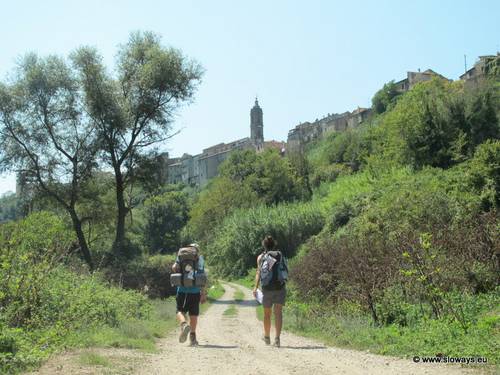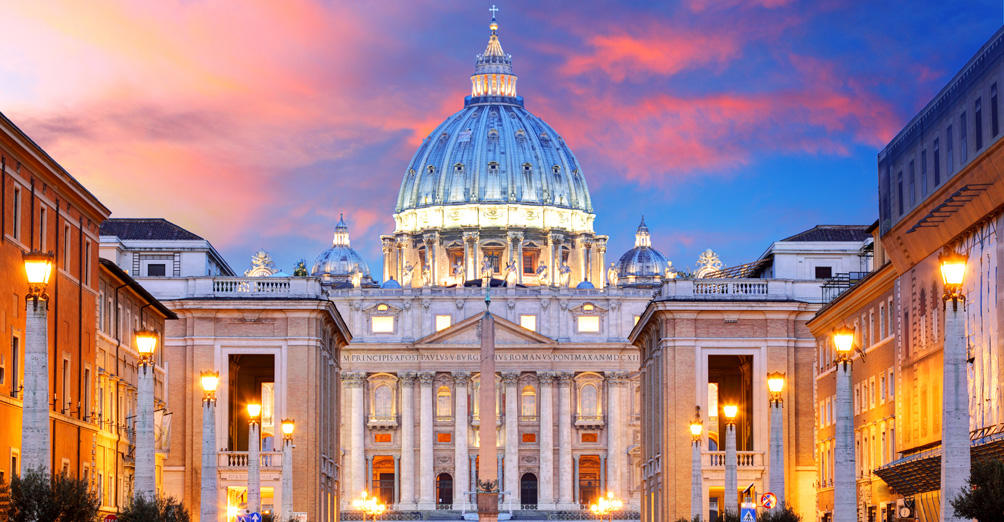WALKERS’
WORLD
Via Francigena
(The Italian Camino)
Guided Walk from Tuscany to Rome
Itinerary
 |
 |
 |
|
Day One:
Meet at our hotel in Orvieto at 3 pm. Orvieto is a stunning town that can be accessed by a direct train from Rome Central Station (Termini). Our accommodation is in the historical centre and in the afternoon we explore on foot. The Cathedral dating back to the 1400's features frescoes by Luca Signorelli that reveal stories of the turbulent political atmosphere of his day. Nearby, we find a collection of medieval palaces where Popes took refuge in the 1300's. Marvel at St Patrick's well that was built to ensure a water supply for the Papal Palace when the town was under siege. Orvieto also boasts a network of Etruscan caves and you learn about these fascinating people who dwelt here prior to the Roman Empire. Today, Orvieto is famous for its white wine. Perhaps sample a glass before dinner. HOTEL GRAND ITALIA Day Two: Walk to Radicofani 18 km (can be reduced to 11) Our private bus takes us to our starting point on the Via Francigena and from here we walk through one of most wild and beautiful sections of the Via Francigena with Mount Amiata in the background. Radicofani is home to one of the most impressive medieval fortresses of Italy. In the days of pilgrimage the castle was the symbol of defence. The town was a stopover and safe haven for pilgrims and stories are told of the Italian version of Robin Hood, Ghino di Tacco, the "Gentleman Bandit" who robbed the rich but spared the poor. From there our private bus returns us to our hotel at Orvieto. HOTEL GRAND ITALIA Day Three: Acquapendente to Bolsena 18 km (can be reduced to 11) Today our starting point is a few km outside the town if Aquapendente. The challenge walkers start here while the easy walkers continue by bus to San Lorenzo Nuovo. The longer walk passes through a territory which is rich in Etruscan archaeological finds. From San Lorenzo di Nuovo it is an easy 11 km walk to the town of Bolsena and soon the sparkling waters of Lake Bolsena come into view. In Bolsena you can visit Monaldeschi Castle and a museum dedicated to the original Etruscan settlement, the Romans and the Middle Ages. Or you may prefer to forget history and enjoy the lakeside cafes and gelato shops along the promenade. HOTEL LORIANA PARK Day Four: Bolsena to Montefiascone 18 km (can be reduced to 12) From Bolsena to Montefiascone the Via Francigena leads through lovely countryside, wooded areas and olive groves that produce some of Italy’s finest olive oil. Some of the walk is on what was once a Roman road and one can still see original Roman paving stones. The walled town of Montefiascone is atop a hill with views of the lovely surrounding countryside and it has changed little since medieval times. You can visit the cathedral and admire the frescoes depicting early martyrs or you can explore the remains of the old Papal summer residence. If you sample the local wine you will no doubt hear the story of how it got its name “Est!Est!!Est!!!”. Legends says that a medieval bishop who was travelling the Via Francigena sent his valet ahead to choose lodging that would serve good wine. The valet was to mark the door with a secret code “est” (Latin for “it is”). When the valet came to Montefiascone he found the wine so good he wrote “Est! Est!! Est!!!”. Local vintners have kept that name and the town still has a reputation for its wine HOTEL URBANO V Day Five: Montefiascone to Viterbo 12 km Today’s walk is short so we can reach Viterbo with enough time and energy to explore the town. The walk is on a plain that divides Lake Bolsena from the Cimini Mountains and a highlight is the Bagnaccio thermal pools where we have a chance to dabble our toes in the six steamy therapeutic pools. From the pools we travel by bus to avoid walking through suburbs of Viterbo. HOTEL MINI PALACE Day Six: Rest day in Viterbo Today there is time to explore this well preserved medieval town. Every twist and turn of the old quarter's narrow streets provides a feast for the eyes. There are several great museums, beautiful churches and pretty piazzas to enjoy but and the biggest attraction is the Papal Palace. Viterbo is called "La Citta' dei Papi" (the City of Popes) and we hear stories of popes and anti-popes, treachery and intrigue. The small museum has displays of Cathedral relics including a reliquary which claims to contain the chin of John the Baptist. But there is more to Viterbo than history and relics. The centre of the town is a treasure trove of gelaterias, cafes, piazzas and fountains. Day Seven: Viterbo to Vetralla 18 km (can be reduced to 12) This morning’s walk starts just outside Viterbo through a canyon cut into soft rock. It then takes us through pretty farmland, mostly flat, with views of the hills in the distance. As we near Vetralla we encounter an old church which is built on the ruins of an ancient staging post that, in medieval times, offered hospitality to pilgrims and travellers, including Archbishop Sigeric (the first person to map the trail) in the year 990. The approach to Vetralla is uphill and local legend says that in Biblical times Noah, escaping the flood, ran his Ark aground here and availed himself of the excellent wines. ANTICO ALBERGO VETRALLA Day Eight Vetralla to Sutri 20 km (can be reduced to 14) Today’s trail starts through hazelnut groves and then is on shady forest trails through a nature reserve. Eventually we pass the "Torri d'Orlando", three ruined towers built along the ancient Via Cassia. The towers were once Roman tombs and there is a legend surrounding them that dates back to Roland, one of Charlemagne’s warriors. The last part of the trail as we approach Sutri is along a stream in the woods and then we find the picturesque town of Sutri. During Roman times it occupied a commanding position on the road to Etruria and one can still see a well-preserved Roman amphitheatre built in the year 1 BC, an Etruscan necropolis from 600 BC and a Cathedral that incorporates an ancient Mithraeum that dates back to Roman times and worship of the mysterious god Mithras. ALBERGO DI SUTRI Day Nine: Sutri to Campagnano di Roma 23 km (can be shortened to 12 km) From Sutri the Via Francigena leads us along quiet country lanes and forest trails to the town of Monterosi. From here the trail continues to Monte Gelato, a lovely wooded area with pretty waterfalls and then on to the town of Campagnano di Roma. This town's medieval borgo has narrow winding streets lined with pastel coloured palazzi, shops and coffee bars. Our accommodation at Il Postiglione has been an inn since 1463 and was once a postal coaching station. Now it is an atmospheric four star inn with a highly regarded restaurant. Il POSTIGLIONE Day Ten: Campagnano di Roma to Rome 17 km (can be reduced to 7 km) Today's walk starts through Veio Park, a 70 sq km nature reserve. At the town of Formello our bus awaits us. By using the bus for this section we avoid the entry into Rome and the traffic. The bus takes us as far as the lovely Monte Mario Park and from here the Via Francigena descends along Via Trionfale to St Peters Square. Those who wish to collect a "Testimonium" certificate can do so at the "Opera Romana Pellegrinaggi". From St Peters we continue to our hotel and later gather at a restaurant for a celebratory dinner.
Day 11: Free day in Rome
|
||||||||